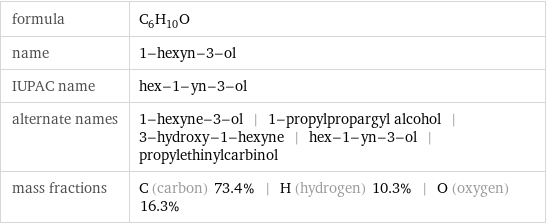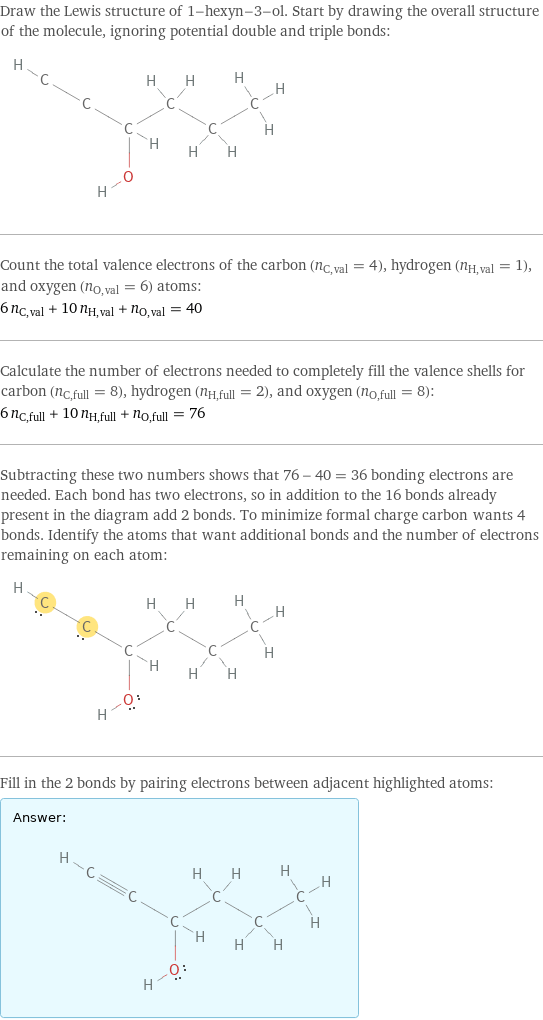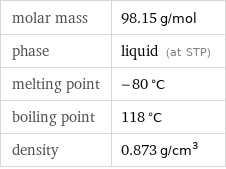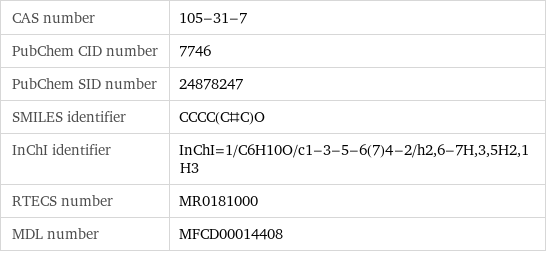Input interpretation

1-hexyn-3-ol
Chemical names and formulas

formula | C_6H_10O name | 1-hexyn-3-ol IUPAC name | hex-1-yn-3-ol alternate names | 1-hexyne-3-ol | 1-propylpropargyl alcohol | 3-hydroxy-1-hexyne | hex-1-yn-3-ol | propylethinylcarbinol mass fractions | C (carbon) 73.4% | H (hydrogen) 10.3% | O (oxygen) 16.3%
Lewis structure

Draw the Lewis structure of 1-hexyn-3-ol. Start by drawing the overall structure of the molecule, ignoring potential double and triple bonds: Count the total valence electrons of the carbon (n_C, val = 4), hydrogen (n_H, val = 1), and oxygen (n_O, val = 6) atoms: 6 n_C, val + 10 n_H, val + n_O, val = 40 Calculate the number of electrons needed to completely fill the valence shells for carbon (n_C, full = 8), hydrogen (n_H, full = 2), and oxygen (n_O, full = 8): 6 n_C, full + 10 n_H, full + n_O, full = 76 Subtracting these two numbers shows that 76 - 40 = 36 bonding electrons are needed. Each bond has two electrons, so in addition to the 16 bonds already present in the diagram add 2 bonds. To minimize formal charge carbon wants 4 bonds. Identify the atoms that want additional bonds and the number of electrons remaining on each atom: Fill in the 2 bonds by pairing electrons between adjacent highlighted atoms: Answer: | |
3D structure

3D structure
Basic properties

molar mass | 98.15 g/mol phase | liquid (at STP) melting point | -80 °C boiling point | 118 °C density | 0.873 g/cm^3
Units

Liquid properties (at STP)

density | 0.873 g/cm^3 refractive index | 1.431
Units

Chemical identifiers

CAS number | 105-31-7 PubChem CID number | 7746 PubChem SID number | 24878247 SMILES identifier | CCCC(C#C)O InChI identifier | InChI=1/C6H10O/c1-3-5-6(7)4-2/h2, 6-7H, 3, 5H2, 1H3 RTECS number | MR0181000 MDL number | MFCD00014408
Safety properties

flash point | 47.22 °C

DOT numbers | 1986
Toxicity properties

RTECS classes | other